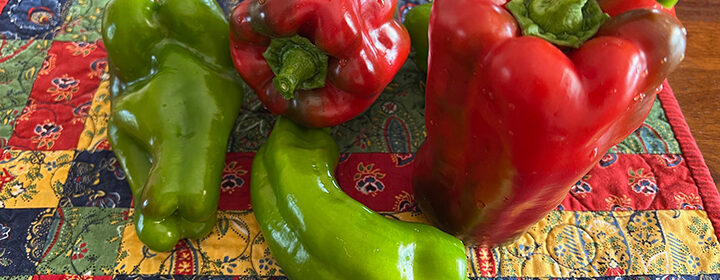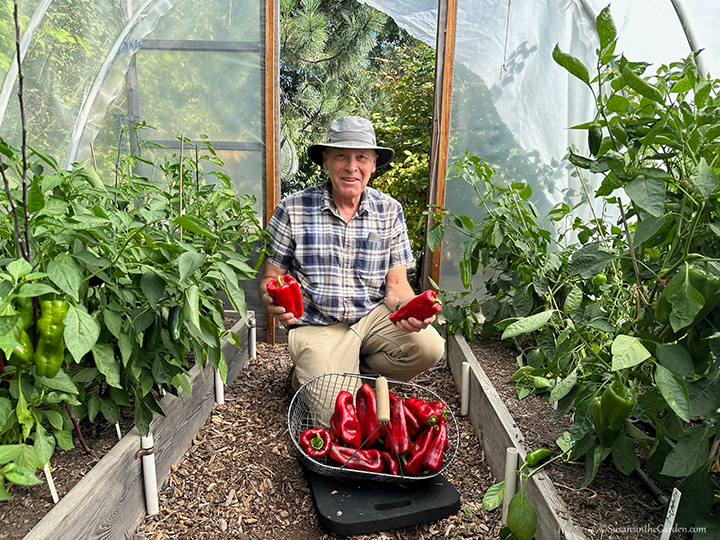How to Grow Peppers

My husband Bill loves to grow peppers every year and has amazing success. He shares his best tips below to help you enjoy growing them in your garden, too. Bill has grown them both in our small hoop house (shown in photo) and out in the garden.
Latin Name: Capsicum annuum
Plant Family: Nightshade (Solanaceae)
Warm-season crop
Did You Know?
The genus for sweet and hot peppers is Capsicum. This refers to the alkaloid capsaicin we’re all familiar with, especially in hot peppers. Sweet peppers have little to no capsaicin in them. Hot peppers can contain alarmingly high amounts which are ranked on the Scoville scale. Milder hot peppers — such as banana, poblano and Anaheim — are rated at 100 to 500 on the scale. Habaneros are toastier at 100,000 to 350,000. The the particularly potent Trinidad Scorpion is listed at up to 1.4 million! Depending on your tolerance to all things spicy, pay close attention when selecting cultivars to grow.
Plant Seeds or Seedlings? Start from seed indoors or purchase plants from a nursery.
When: To grow peppers, start seeds about 8 weeks before the average last frost date. Transplant seedlings outdoors once all danger of frost has passed and they have been through a weeklong hardening-off process. This involves slowly acclimating them to the intensity of the sunlight over the course of about a week.
Days to Germination: 14 to 21 days
Depth to Sow: 1/4 inch
Spacing: Plant seedlings 12 inches apart in garden.
Days to Maturity: sweet peppers 55 to 70 days; hot peppers 66 to 80 days
Cultural Information:
Remember that all members of the Nightshade family should be planted in different locations each year for a 3-year period. This helps reduce the chance of plant diseases and insect issues.
Peppers benefit from being planted deeply because they will form additional roots along their central stem. This makes the plants stronger and gives them the ability to take up more nutrients and moisture from the soil.
Prior to planting, prepare bed by working compost and bonemeal into the top 3 inches of the soil. When planting, remove the lowest pair of leaves as long as there are at least two remaining pairs of leaves. Place the plants deeply into their holes, with the soil just below the lowest remaining leaves.
Feed with an organic nitrogen fertilizer such as fish emulsion diluted at half-strength and 2 weeks later. Cover the bed with a sheet of floating row cover to further keep the plants warm; remove two weeks later. We have found that pepper plants really thrive and produce if they are kept warm. We often grow the pepper crop in our hoop house, where most of the plants reach 3 feet in height! Since plants can topple over from the weight of the developing peppers, it’s a good idea to stake them.
Peppers can suffer from sunscald (sunburn), be sure to keep them well-watered. That way, there will be plenty of leaves to shade the fruits. Consider placing a cover of shade cloth over the crop before summertime temperatures become intense.
Bill’s Picks: (hot) ‘Classic Jalapeno’, ‘Early Jalapeno’, ‘Highlander’. (sweet) ‘Corno di Toro’, ‘Marconi Rosso’, ‘Stuff Enuff’.
When to Harvest:
You can pick peppers while their skin is green. If you let them mature, however, the skin will turn red, orange, purple, or chocolate color, depending on the cultivar. The longer you leave the peppers on the plants, the more flavorful they will become. Be sure to harvest while the peppers are firm rather than soft.
How to Cook & Preserve:
Both sweet and hot peppers are delicious eaten fresh either as an appetizer or in freshly-made salsa. Other options include stuffing and baking them, or grilling and frying them. You can add them to sauces, pasta, pizza or casseroles. To preserve peppers, either freeze them for later use or can them. To freeze, chop and place them in freezer bags. It’s also possible to water-bath can pickled peppers in a vinegar brine.
My Videos About Growing Peppers:
- (coming!)
Back to Vegetable Grow Guide Chart
Copyright: Susan Mulvihill, Susan’s in the Garden, SusansintheGarden.com.

